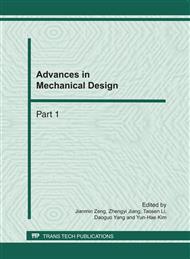p.913
p.922
p.927
p.931
p.936
p.941
p.945
p.949
p.953
Vibration Analysis and Optimal Design for Cab’s Isolation System of Vibratory Roller
Abstract:
In recent years, vibration roller market has required increasingly not only on working capacity but also ride comfort. Thus, in order to reduce the effect of vibration to operators, identification and elimination of vibration sources are the most important tasks to achieve optimum design. In this paper, the attention is paid to cab’s low-frequency sloshing analysis and optimal design for cab’s isolation system of vibratory roller. When working, it often exists the problem of cab’s low-frequency sloshing in the direction of forward motion. In order to solve this problem, the dynamic test and simulations analysis are carried out; and the main reasons causing cab’s low-frequency sloshing are found out. The optimization model according to the two points response amplitude in the direction of forward motion on the cab to reach the minimum value in the low frequency range is proposed in this paper. And also, the auxiliary vibrations isolator for solving the low-frequency sloshing in the direction of forward motion is designed.
Info:
Periodical:
Pages:
936-940
Citation:
Online since:
February 2011
Authors:
Price:
Сopyright:
© 2011 Trans Tech Publications Ltd. All Rights Reserved
Share:
Citation:


